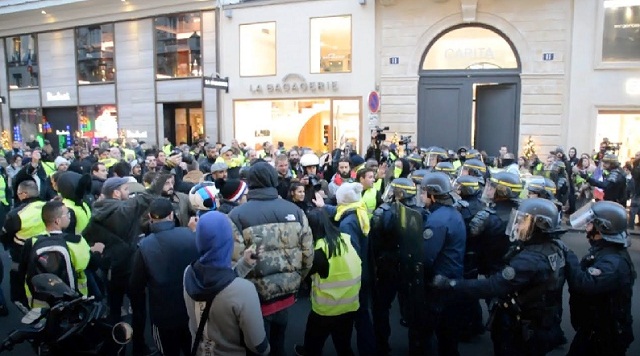
Paris, France | AFP | Protests by people clad in luminous vests have played havoc with traffic across France and prompted violent clashes in Paris in recent days. But who are the “yellow vest” protesters, and what will become of them?
What are these protests about?
The movement sprang up spontaneously last month against hikes in car fuel taxes, with supporters donning the safety vests carried in all French vehicles.
Backed by people in small towns and the countryside where most get around by car, it has snowballed into a wider movement against President Emmanuel Macron’s perceived bias in favour of the rich and big cities.
After nationwide road blockades that have left two people dead in accidents, last weekend’s violent demo in Paris symbolised a perceived gulf between urban elites and “left-behind” provincial France.
Supporters’ goals are amorphous. Many complain they barely scrape by and get scant public services in exchange for some of the highest tax bills in Europe.
Some want to reverse Macron’s tax cuts for the rich while others want more measures to help the poorest.
Many have called on the business-friendly president, a former investment banker, to resign.
What makes these protests different?
France has a long history of protest movements which have flared and waned, opposing everything from fuel taxes to gay marriage.
Analysts say what makes the “yellow vests” unusual is the way their movement has coalesced without leaders, organised via social media.
They also hail from a range of social and political backgrounds, though the government has blamed far-right supporters for the violence on the Champs-Elysees last weekend.
As a relatively broad alliance, it stands in contrast to another spontaneous movement that spread across France in 2016, “Nuit Debout” or “Up All Night”, which was leftist.
“There are people who voted for the (far-right) National Rally, but also lots of people who don’t vote and people who voted for Macron,” said Danielle Tartakowsky, a professor of contemporary history at Paris 8 university.
Can they last?
Until now, the yellow vests have enjoyed fairly wide public support: a poll last week showed around 70 percent found the protests justified.
A first day of action on November 17 saw some 300,000 people turn out nationwide to man roadblocks, with sporadic protests continuing through the week.
But last Saturday only about 100,000 took part, prompting suggestions that the protests are on the wane.
“The movement could well disappear by attrition,” said Jerome Saint-Marie, head of research agency Pollingvox.
“If next Saturday there are only 50,000 people, it’s over,” he predicted.
But what began as what Saint-Marie called a “spontaneous and horizontal” movement has now indicated it is seeking to become more organised.
The yellow vests announced Monday that they are nominating an eight-person delegation to negotiate with the government.
Environment Minister Francois de Rugy is due to meet with members of the movement for the first time as early as Tuesday.
How has Macron reacted?
Macron came to power vowing to restore trust in politics, but the protests have brought widespread anger over his pro-business policies and perceived elitism to the streets.
With approval ratings languishing at around 30 percent, many protesters regard him as arrogant and out of touch with people living modest lives in provincial France.
 The Independent Uganda: You get the Truth we Pay the Price
The Independent Uganda: You get the Truth we Pay the Price


